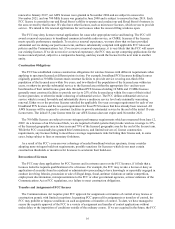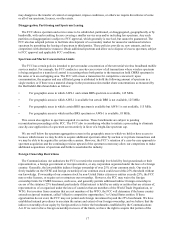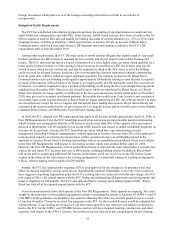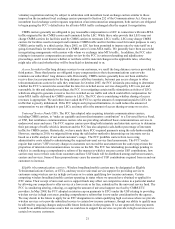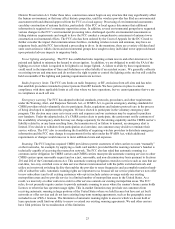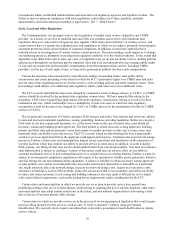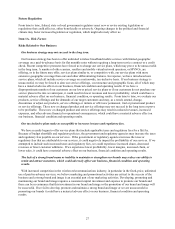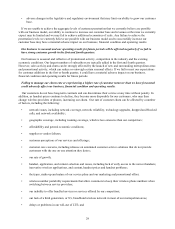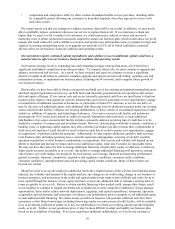Metro PCS 2009 Annual Report Download - page 35
Download and view the complete annual report
Please find page 35 of the 2009 Metro PCS annual report below. You can navigate through the pages in the report by either clicking on the pages listed below, or by using the keyword search tool below to find specific information within the annual report.23
Historic Preservation Act. Under these rules, construction cannot begin on any structure that may significantly affect
the human environment, or that may affect historic properties, until the wireless provider has filed an environmental
assessment with and obtained approval from the FCC or a local agency. Processing of environmental assessments
can delay construction of antenna facilities, particularly if the FCC or local agency determines that additional
information is required or if community opposition arises. In addition, several environmental groups have requested
various changes to the FCC’s environmental processing rules, challenged specific environmental assessments as
failing statutory requirements and sought to have the FCC conduct a comprehensive assessment of antenna tower
construction environmental effects. The FCC also has been ordered by the Court of Appeals for the DC Circuit to
further consider the impact that communications facilities, including wireless towers and antennas, may have on
migratory birds, and the FCC has initiated a proceeding to do so. In the meantime, there are a variety of federal and
state court actions in which citizen and environmental groups have sought to deny individual tower approvals based
upon potential adverse impacts to migratory birds.
Tower lighting and painting. The FCC has established rules requiring certain towers and other structures to be
painted and lighted to minimize the hazard to air navigation. In addition, we are obligated to notify the FAA if the
lighting at a tower which is required to be lighted is no longer lighted. A failure to abide by these requirements
could result in the imposition of fines and forfeitures or other liability if an accident occurs. We generally collocate
on existing towers and structures and do not have the right to paint or control the lighting at the site but still could be
held accountable if the lighting and painting requirements are not met.
Radio frequency limits. The FCC sets limits on radio frequency, or RF, emissions from cell sites and has rules
that establish procedures intended to protect persons from RF hazards. We have policies in place to ensure
compliance with these applicable limits at cell sites where we have operations, but we cannot guarantee that we are
in compliance at each cell site.
Emergency warning. The FCC has adopted technical standards, protocols, procedures, and other requirements
under the Warning, Alert, and Response Network Act, or WARN Act, to govern emergency alerting standards for
CMRS providers which voluntarily elect to participate. Rules, regulations and industry protocols are in the process
of being developed to implement this program. We have elected to participate in the voluntary emergency alert
program. This election may cause us to incur costs and expenses and our customers may be required to purchase
new handsets. Under the adopted rules, if a CMRS carrier elects to participate, the carrier must notify customers of
the availability of emergency alerts but may not charge separately for the alerting capability and the CMRS carrier’s
liability related to, or any harm resulting from, the transmission of, or failure to transmit, an emergency alert is
limited. If we decide to withdraw from participation at a later date, our customers may decide to terminate their
service with us. The FCC also is considering the feasibility of requiring wireless providers to distribute emergency
information and the FCC may change its requirements for the rules under the WARN Act, which additional
requirements or changes would cause us to incur additional costs and expenses.
Roaming. The FCC long has required CMRS providers to permit customers of other carriers to roam “manually”
on their networks, for example, by supplying a credit card number, provided that the roaming customer’s handset is
technically capable of accessing the roamed-on network. The FCC also has ruled that automatic roaming is a
common carrier obligation for CMRS carriers and CMRS carriers must provide automatic roaming services to other
CMRS carriers upon reasonable request and on a just, reasonable, and non-discriminatory basis pursuant to Sections
201 and 202 of the Communications Act. This automatic roaming obligation extends to services such as ours that are
real-time, two-way switched voice or data services that are interconnected with the public switched network and
utilize an in-network switching facility that enables the provider to reuse frequencies and accomplish seamless hand-
offs of subscriber calls. Automatic roaming rights are important to us because all our service plans that we now offer
to new subscribers (and to all existing customers who opt-in) include certain coverage outside our existing
metropolitan areas and we provide service in a limited number of metropolitan areas in the United States. As a
result, we must rely on other carriers in order to offer services outside our existing metropolitan areas. The FCC
rules, do not presently require carriers to provide automatic roaming to areas where the roamer’s home carrier holds
licenses or otherwise has spectrum usage rights. This in-market limitation may preclude our customers from
receiving automatic roaming in large portions of the United States where we hold licenses but have not yet built
networks or offer services and do not have existing long-term roaming agreements, such as the geographic areas
included in our AWS-1 licenses. The limitation of automatic roaming rights to areas in which we do not hold or
lease spectrum could limit our ability to renew or extend our existing roaming agreements. We and other carriers
have filed petitions for reconsideration of this limitation.





